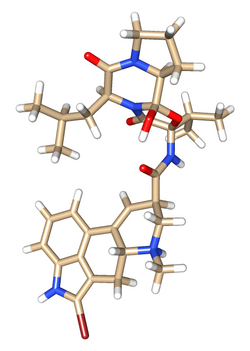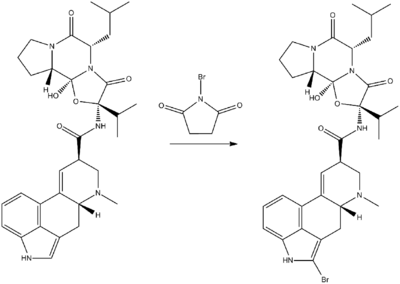Chemistry:Bromocriptine
 | |
| Clinical data | |
|---|---|
| Trade names | Originally Parlodel, subsequently many[1] |
| Other names | 2-Bromoergocriptine; CB-154 |
| AHFS/Drugs.com | Monograph, International Drug Names |
| MedlinePlus | a682079 |
| Pregnancy category |
|
| Routes of administration | By mouth, vaginal, intravenous |
| ATC code | |
| Legal status | |
| Legal status | |
| Pharmacokinetic data | |
| Bioavailability | 28% of oral dose absorbed |
| Metabolism | Extensively liver-mediated |
| Elimination half-life | 12–14 hours |
| Excretion | 85% bile (feces), 2.5–5.5% urine |
| Identifiers | |
| |
| CAS Number | |
| PubChem CID | |
| IUPHAR/BPS | |
| DrugBank | |
| ChemSpider | |
| UNII | |
| KEGG | |
| ChEBI | |
| ChEMBL | |
| Chemical and physical data | |
| Formula | C32H40BrN5O5 |
| Molar mass | 654.606 g·mol−1 |
| 3D model (JSmol) | |
| |
| |
| (verify) | |
Bromocriptine, originally marketed as Parlodel and subsequently under many brand names,[1] is an ergoline derivative and dopamine agonist that is used in the treatment of pituitary tumors, Parkinson's disease, hyperprolactinaemia, neuroleptic malignant syndrome, and, as an adjunct, type 2 diabetes.
It was patented in 1968 and approved for medical use in 1975.[2]
Medical uses
Bromocriptine is used to treat acromegaly and conditions associated with hyperprolactinemia like amenorrhea, infertility, hypogonadism, and prolactin-secreting adenomas. It is also used to prevent ovarian hyperstimulation syndrome[3][4][5] and to treat Parkinson's disease.[3]
Since the late 1980s it has been used, off-label, to reduce the symptoms of cocaine withdrawal but the evidence for this use is poor.[6] Bromocriptine has been successfully used in cases of galactorrhea precipitated by dopamine antagonists like risperidone.
A quick-release formulation of bromocriptine, Cycloset, is also used to treat type 2 diabetes.[7][8][9] When administered within 2 hours of awakening, it increases hypothalamic dopamine level and as a result decreases hepatic glucose production. It therefore acts as an adjunct to diet and exercise to improve glycemic control.[10]
Side effects
Most frequent side effects are nausea, orthostatic hypotension, headaches, and vomiting through stimulation of the brainstem vomiting centre.[11] Vasospasms with serious consequences such as myocardial infarction and stroke that have been reported in connection with the puerperium, appear to be extremely rare events.[12] Peripheral vasospasm (of the fingers or toes) can cause Raynaud's Phenomenon. Bromocriptine use has been anecdotally associated with causing or worsening psychotic symptoms (its mechanism is in opposition of most antipsychotics, whose mechanisms generally block dopamine receptors).[13] It should be understood, however, that the greater affinity bromocriptine and many similar antiparkinson's drugs have for the D2S receptor form (considered to be mostly present at inhibitory D2 autoreceptor locatations)[14] relative to the D2L form, sufficiently low partial agonist activity (ie where a molecule binding to a receptor induces limited effects while preventing a stronger ligand like dopamine from binding), and, possibly, the functional selectivity of a particular drug may generate antidopaminergic effects that are more similar than oppositional in nature to antipsychotics. Pulmonary fibrosis has been reported when bromocriptine was used in high doses for the treatment of Parkinson's disease.[15]
Use to suppress milk production after childbirth was reviewed in 2014 and it was concluded that in this context a causal association with serious cardiovascular, neurological or psychiatric events could not be excluded with an overall incidence estimated to range between 0.005% and 0.04%. Additional safety precautions and stricter prescribing rules were suggested based on the data.[16][17] It is a bile salt export pump inhibitor.[18]
After long-term use of dopamine agonists, a withdrawal syndrome may occur during dose reduction or discontinuation with the following possible side effects: anxiety, panic attacks, dysphoria, depression, agitation, irritability, suicidal ideation, fatigue, orthostatic hypotension, nausea, vomiting, diaphoresis, generalized pain, and drug cravings. For some individuals, these withdrawal symptoms are short-lived and they make a full recovery, for others a protracted withdrawal syndrome may occur with withdrawal symptoms persisting for months or years.[19]
Pharmacology
Pharmacodynamics
Bromocriptine is a partial agonist of the dopamine D2 receptor.[20][21][22] It also interacts with other dopamine receptors and with various serotonin and adrenergic receptors.[20][21][23] Bromocriptine has additionally been found to inhibit the release of glutamate by reversing the GLT1 glutamate transporter.[24]
As an antagonist of the serotonin 5-HT2B receptor,[23] bromocriptine has not been associated with cardiac valvulopathy.[25] This is in contrast to other ergolines acting instead as 5-HT2B receptor agonists such as cabergoline and pergolide but is similar to lisuride which likewise acts as a 5-HT2B receptor antagonist.[25]
| Site | Affinity (Ki [nM]) | Efficacy (Emax [%]) | Action |
|---|---|---|---|
| D1 | 692 | ? | ? |
| D2S | 5.0 | 41 | Partial agonist |
| D2L | 15 | 28 | Partial agonist |
| D3 | 6.8 | 68 | Partial agonist |
| D4 | 372 | 0 | Silent antagonist |
| D5 | 537 | ? | ? |
| 5-HT1A | 13 | 72 | Partial agonist |
| 5-HT1B | 355 | 66 | Partial agonist |
| 5-HT1D | 11 | 86 | Partial agonist |
| 5-HT2A | 107 | 69 | Partial agonist |
| 5-HT2B | 56 | 0 | Silent antagonist |
| 5-HT2C | 741 | 79 | Partial agonist |
| 5-HT6 | 33 | ? | ? |
| 5-HT7 | 11–126 | ? | ? |
| α1A | 4.2 | 0 | Silent antagonist |
| α1B | 1.4 | ? | ? |
| α1D | 1.1 | ? | ? |
| α2A | 11 | 0 | Silent antagonist |
| α2B | 35 | 0 | Silent antagonist |
| α2C | 28 | 0 | Silent antagonist |
| α2D | 68 | ? | ? |
| β1 | 589 | ? | ? |
| β2 | 741 | ? | ? |
| H1 | >10,000 | – | – |
| M1 | >10,000 | – | – |
| Notes: All receptors are human except α2D-adrenergic, which is rat (no human counterpart), and 5-HT7, which is rat/mouse.[20][26] | |||
Chemistry
Like all ergopeptides, bromocriptine is a cyclol; two peptide groups of its tripeptide moiety are crosslinked, forming the >N-C(OH)< juncture between the two rings with the amide functionality.
Bromocriptine is a semisynthetic derivative of a natural ergot alkaloid, ergocryptine (a derivative of lysergic acid), which is synthesized by bromination of ergocryptine using N-bromosuccinimide.[27][28]
History
Bromocriptine was discovered by scientists at Sandoz in 1965 and was first published in 1968; it was first marketed under the brand name Parlodel.[29][30]
A quick-release formulation of bromocriptine was approved by the FDA in 2009.[31]
Society and culture
Brand names
As of July 2017, bromocriptine was marketed under many brand names worldwide, including Abergin, Barlolin, Brameston, Brocriptin, Brom, Broma-Del, Bromergocryptine, Bromergon, Bromicon, Bromocorn, Bromocriptin, Bromocriptina, Bromocriptine, Bromocriptine mesilate, Bromocriptine mesylate, Bromocriptine methanesulfonate, Bromocriptini mesilas, Bromocriptinmesilat, Bromodel, Bromokriptin, Bromolac, Bromotine, Bromtine, Brotin, Butin, Corpadel, Cripsa, Criptine, Criten, Cycloset, Degala, Demil, Deparo, Deprolac, Diacriptin, Dopagon, Erenant, Grifocriptina, Gynodel, kirim, Kriptonal, Lactodel, Medocriptine, Melen, Padoparine, Palolactin, Parlodel, Pravidel, Proctinal, Ronalin, Semi-Brom, Serocriptin, Serocryptin, Suplac, Syntocriptine, Umprel, Unew, Updopa, Upnol B, and Volbro.[1]
As of July 2017 it was also marketed as a combination drug with metformin as Diacriptin-M, and as a veterinary drug under the brand Pseudogravin.[1]
References
- ↑ 1.0 1.1 1.2 1.3 "Bromocriptine international brand names". Drugs.com. https://www.drugs.com/international/bromocriptine.html.
- ↑ (in en) Analogue-based Drug Discovery. John Wiley & Sons. 2006. p. 533. ISBN 9783527607495. https://books.google.com/books?id=FjKfqkaKkAAC&pg=PA533.
- ↑ 3.0 3.1 "Bromocriptine mesylate tablets -- original uses". FDA. January 2012. https://www.accessdata.fda.gov/drugsatfda_docs/label/2012/017962s065s068lbl.pdf. For label updates see FDA index page for NDA 017962
- ↑ "Diagnosis and Treatment of Pituitary Adenomas: A Review". JAMA 317 (5): 516–524. February 2017. doi:10.1001/jama.2016.19699. PMID 28170483.
- ↑ "Dopamine agonists for preventing ovarian hyperstimulation syndrome". The Cochrane Database of Systematic Reviews 2021 (4): CD008605. 14 Apr 2021. doi:10.1002/14651858.CD008605.pub4. PMID 33851429.
- ↑ "Dopamine agonists for the treatment of cocaine dependence". The Cochrane Database of Systematic Reviews 2015 (5): CD003352. May 2015. doi:10.1002/14651858.CD003352.pub4. PMID 26014366.
- ↑ "Bromocriptine mesylate tablet label". FDA. February 2017. https://www.accessdata.fda.gov/drugsatfda_docs/label/2017/020866s006s007lbl.pdf.. For label updates see FDA index page for NDA 020866
- ↑ "The role of bromocriptine-QR in the management of type 2 diabetes expert panel recommendations". Endocrine Practice 19 (1): 100–6. 2013. doi:10.4158/EP12325.OR. PMID 23337160.
- ↑ "Efficacy and Safety of Bromocriptine-QR in Type 2 Diabetes: A Systematic Review and Meta-Analysis". Hormone and Metabolic Research 47 (11): 805–12. October 2015. doi:10.1055/s-0035-1559684. PMID 26332757.
- ↑ "Bromocriptine: a sympatholytic, d2-dopamine agonist for the treatment of type 2 diabetes". Diabetes Care 34 (4): 789–94. April 2011. doi:10.2337/dc11-0064. PMID 21447659.
- ↑ "The safety of bromocriptine in long-term use: a review of the literature". Current Medical Research and Opinion 10 (1): 25–51. 1986. doi:10.1185/03007998609111089. PMID 3516579.
- ↑ "Bromocriptine related atypical vascular accidents postpartum identified through medicolegal reviews". Medicine and Law 15 (1): 127–34. 1996. PMID 8691994.
- ↑ "Bromocriptine and psychosis: a literature review". The Psychiatric Quarterly 66 (1): 87–95. 1995. doi:10.1007/BF02238717. PMID 7701022.
- ↑ Ford, CP (Jan 23, 2004). "The role of D2-autoreceptors in regulating dopamine neuron activity and transmission". Neuroscience 282: 13–22. doi:10.1016/j.neuroscience.2014.01.025. PMID 24463000.
- ↑ "Pleuropulmonary fibrosis due to bromocriptine treatment for Parkinson's disease". Clinical and Experimental Neurology 27: 79–82. 1990. PMID 2129961.
- ↑ "European Medicines Agency - News and Events - CMDh endorses restricted use of bromocriptine for stopping breast milk production". 2018-09-17. http://www.ema.europa.eu/ema/index.jsp?curl=pages/news_and_events/news/2014/08/news_detail_002157.jsp&mid=WC0b01ac058004d5c1.
- ↑ "EMA rät vom Abstillmittel Bromocriptin ab". 2014-08-25. http://m.aerzteblatt.de/news/59857.htm. "EMA rät vom Abstillmittel Bromocriptin ab", article in Ärzteblatt
- ↑ "Flagging Drugs That Inhibit the Bile Salt Export Pump". Molecular Pharmaceutics 13 (1): 163–71. January 2016. doi:10.1021/acs.molpharmaceut.5b00594. PMID 26642869. http://www.zora.uzh.ch/id/eprint/118806/1/acs.molpharmaceut.pdf.
- ↑ "Dopamine agonist withdrawal syndrome: implications for patient care". Drugs & Aging 30 (8): 587–92. August 2013. doi:10.1007/s40266-013-0090-z. PMID 23686524.
- ↑ 20.0 20.1 20.2 20.3 "Differential actions of antiparkinson agents at multiple classes of monoaminergic receptor. I. A multivariate analysis of the binding profiles of 14 drugs at 21 native and cloned human receptor subtypes". J Pharmacol Exp Ther 303 (2): 791–804. November 2002. doi:10.1124/jpet.102.039867. PMID 12388666.
- ↑ 21.0 21.1 21.2 "Differential actions of antiparkinson agents at multiple classes of monoaminergic receptor. II. Agonist and antagonist properties at subtypes of dopamine D(2)-like receptor and alpha(1)/alpha(2)-adrenoceptor". J Pharmacol Exp Ther 303 (2): 805–14. November 2002. doi:10.1124/jpet.102.039875. PMID 12388667.
- ↑ "The dopamine receptor D2 agonist bromocriptine inhibits glucose-stimulated insulin secretion by direct activation of the alpha2-adrenergic receptors in beta cells". Biochemical Pharmacology 79 (12): 1827–36. June 2010. doi:10.1016/j.bcp.2010.01.029. PMID 20138024.
- ↑ 23.0 23.1 23.2 "Differential actions of antiparkinson agents at multiple classes of monoaminergic receptor. III. Agonist and antagonist properties at serotonin, 5-HT(1) and 5-HT(2), receptor subtypes". J Pharmacol Exp Ther 303 (2): 815–22. November 2002. doi:10.1124/jpet.102.039883. PMID 12388668.
- ↑ "Bromocriptine, an ergot alkaloid, inhibits excitatory amino acid release mediated by glutamate transporter reversal". European Journal of Pharmacology 643 (1): 48–57. September 2010. doi:10.1016/j.ejphar.2010.06.007. PMID 20599932.
- ↑ 25.0 25.1 "Safety Pharmacology assessment of drugs with biased 5-HT(2B) receptor agonism mediating cardiac valvulopathy". J Pharmacol Toxicol Methods 69 (2): 150–61. 2014. doi:10.1016/j.vascn.2013.12.004. PMID 24361689.
- ↑ 26.0 26.1 National Institute of Mental Health. PDSP Ki Database (Internet). ChapelHill (NC): University of North Carolina. Available from: "PDSP Database - UNC". http://pdsp.med.unc.edu/pdsp.php.
- ↑ E. Fluckiger, A. Hofmann, U.S. Patent 3,752,814 (1973)
- ↑ Hofmann, Albert; Edward Flueckiger & Franz Troxler, "Verfahren zur Herstellung einer neuen heterocyclischen Verbindung [Process for the preparation of a new heterocyclic compound]", DE patent 1926045A1, published 1969-12-04
- ↑ (in en) Drug Discovery: A History. John Wiley & Sons. 2005. p. 352. ISBN 9780471899792. https://books.google.com/books?id=Cb6BOkj9fK4C&pg=PA352.
- ↑ "Fungal Metabolites as Pharmaceuticals". Australian Journal of Chemistry 67 (6): 827. 2014. doi:10.1071/CH13639.
- ↑ "Bromocriptine: old drug, new formulation and new indication". Diabetes, Obesity & Metabolism 12 (12): 1048–57. December 2010. doi:10.1111/j.1463-1326.2010.01304.x. PMID 20977575.
External links
 |



